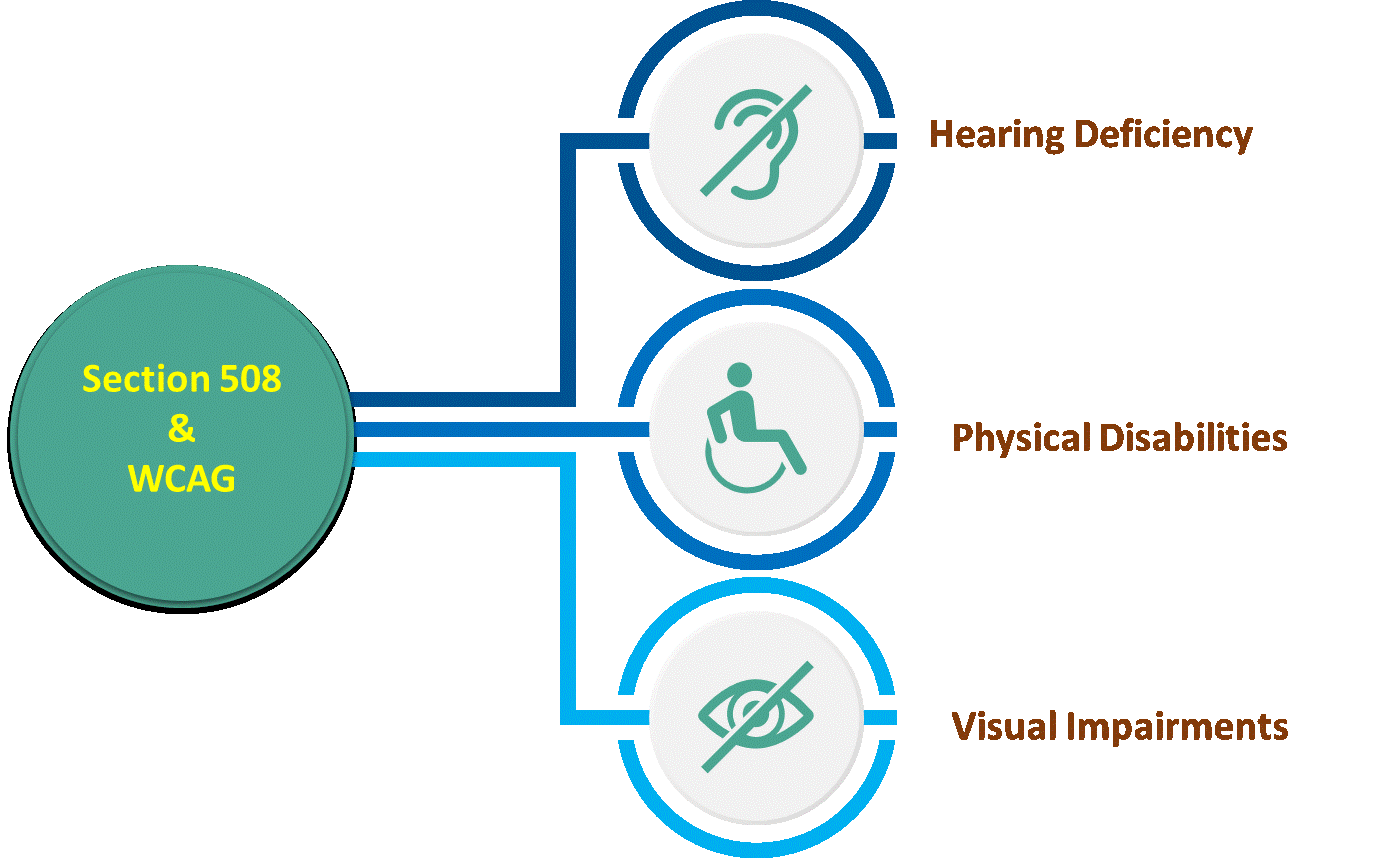Purpose of the article: The purpose of the document is to provide a comprehensive guide on Accessibility Testing and Section 508 Compliance. It covers the significance of making digital content accessible to individuals with disabilities, explaining Section 508 and its compliance requirements.
Intended Audience: Automation Engineers /QA Managers/ QA Director/QA Organizations
Tools and Technology: VoiceOver, aDesigner, Adobe Dreamweaver & NVDA
Keywords: Accessibility Testing, 508 Compliance, WCAG
1. Introduction
Accessibility testing is a software Quality Assurance (QA) procedure to ensure that an application is optimally usable, even by those with impairments and other disadvantages. It belongs to the Usability Testing subset. To verify that your websites, products, and services are Section 508 compliant, you are required to conduct accessibility testing, audits, and reviews.
2. Understanding Section 508
A modification to the Rehabilitation Act of 1973, a federal accessibility statute in the United States, is Section 508. It is essentially a piece of federal government procurement software designed to ensure that every information and communications technology (ICT) created, acquired, maintained, or used by federal agencies is accessible to those with disabilities. As a result, Section 508 Compliance testing has grown to be a crucial component of software and web design, especially for businesses and organizations that cooperate with the government.
3. Why Section 508 Compliance Matters
Whether or not Section 508 is applicable, making web material accessible to all users is the morally right thing to do for any organization. For covered entities, failing to comply with Section 508 may mean paying significant fines. Government contracts held by private enterprises are also in danger of non-compliance. This is due to the need for any ICT sold by the organization to federal agencies to comply with Section 508.
4. Section 508 Compliance Content Type
- Website material
- Mobile applications
- Application platforms or software and operating systems (web-based and stand-alone)
- Records and PDFs
- E-learning courses
- Tables and worksheets
- Presentations with audio and video
5. Benefits of Section 508 Compliance Testing
508 Compliance ensures equal access and usability of digital content and technology for disabled individuals. Below are a few key reasons:
Inclusivity and Equal Access: 508 Compliance ensures that individuals with disabilities, including visual, auditory, cognitive, and motor impairments, can access and interact with digital content on an equal footing with those without disabilities.
Expanded Audience Reach: Designing digital resources with accessibility in mind broadens the reach of your content, making it accessible to a larger audience, including people with disabilities, elderly individuals, and those using assistive technologies.
Positive Brand Image: Prioritizing accessibility demonstrates your commitment to inclusivity and social responsibility. It enhances your organization’s reputation and can attract a more diverse and loyal user base.
Avoiding Future Costs: Retrofitting non-compliant digital resources can be time-consuming and expensive. Incorporating accessibility from the start is more cost-effective and prevents the need for extensive revisions later.
Innovation: The challenge of designing for accessibility often drives innovation in user interface design, leading to creative solutions that benefit all users.

6. Web Content Accessibility Guidelines (WCAG) 2.0
WCAG conformance testing is used to verify Section 508 compliance. A set of guidelines known as WCAG was developed by the Web Accessibility Initiative (WAI). WAI is a member of the World Wide Web Consortium (W3C). WCAG ensures a global gold standard for accessible web content.
WCAG 2.0 Level AA compliance is now listed as Section 508’s compliance standard. Therefore, ICT will successfully comply with Section 508 requirements if it meets all WCAG 2.0 AA criteria. A high level of accessibility is Level AA.
7. Section 508 Compliance Testing
The process typically involves testing against WCAG success criteria using the following:
7.1 Automated Testing:
There are many accessibility automated testing tools available to scan your ICT and generate a list of barriers that need to be fixed.
7.2 Manual Testing:
Provided you have access to screen readers and other standard assistive tools, you can test ICT manually to obtain a better idea of how accessible it is.
7.3Hybrid Testing:
Section 508 testing is complex, and combining methods allows one to cover more bases.
8. Tools to Ensure 508 Compliance
Below are a few tools to ensure that applications are 508 compliant.
8.1 PDF 508 Compliance Tools
8.2 Screen Reader 508 Compliance Tools
- VoiceOver
- Designer
- Adobe Dreamweaver
- NVDA
8.3 Word Document 508 Compliance Tool
- Accessibility Checker-MS Word
8.4 Web Page 508 Compliance Tools
- Accessibility Checker
- Equal Web
- Functional Accessibility Evaluator (FAE)
- Web Accessibility Inspector
- WAVE Web Accessibility Evaluation Tool
- Accessibility Developers Tools by Google
Conclusion:
Testing for Section 508 Compliance is crucial in ensuring electronic and informational technology is accessible to all users – including those with impairments. Digital content creators can ensure that their works adhere to the Section 508 guidelines accessibility requirements by using this testing procedure.
Businesses and organizations may build a more inclusive digital environment for all users by prioritizing accessibility, and, Section 508 Compliance testing brings us closer to creating a more open and just society.
References:
Author Bio:

Praveen DUGGIRALA
Sr Principal Software Engineer - IQE
Have good experience in Software Testing including Manual Testing, API Testing, Device Testing, SQL Queries Testing in different domains like Enterprise Learning Management System (ELMS), Banking and Financial Services (BFS), Human Capital Management (HCM), and Geographical Information Systems (GIS).


